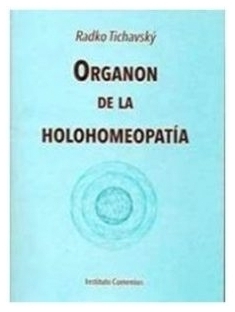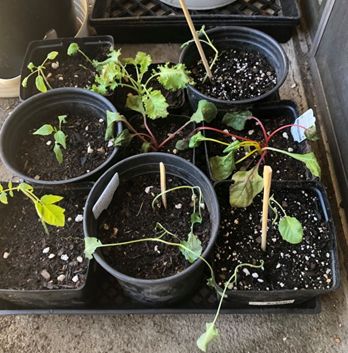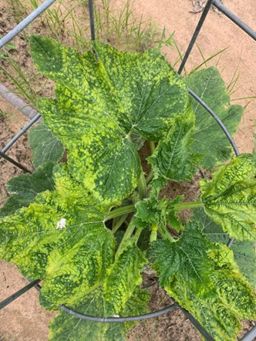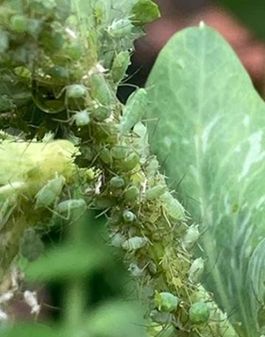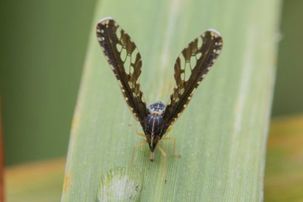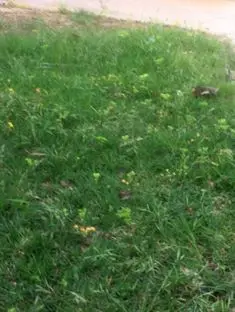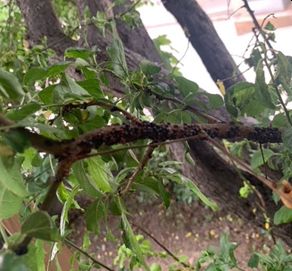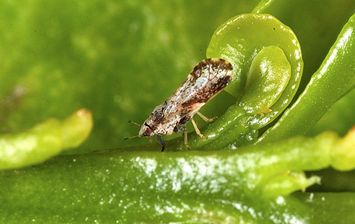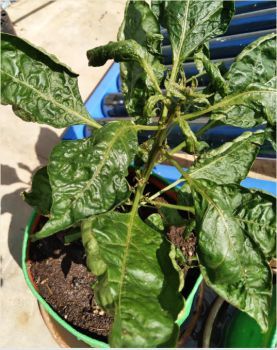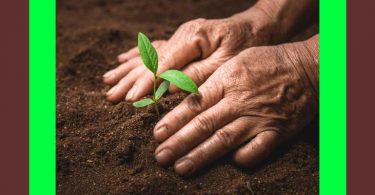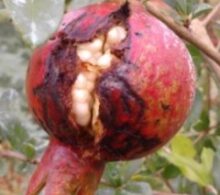Radko Tichavsky is a Czech born Mexican Agrohomeopath. He is a co-founder and director of Instituto Comenius in Mexico and author of Handbook of Agrohomeopathy, 2007 (Spanish) and Homeopathy for Plants, 2009 (Spanish), Organon de la Holohomeopatía and creator and teacher of Holohomeopathy.
He is now offering a one-semester virtual course in Holohomeopathy (in English). You can learn how to define and analyze holons and how to repertorize the specific homeopathic treatment beyond just disease or pest names. You can find out more here: www.icomenius.edu.mx
NEW BOOK: Organon de la Holohomeopatía
Six years in the making, it is the latest book by Radko Tichavsky, researcher on the application of homeopathy in agriculture. This Spanish language book covers homeopathic interventions in agriculture from the holistic view, allowing greater certainty in repertorizations. It addresses a novel concept of metabolic similarity, not only among plants, but also among different species of the animal and plant kingdom. It studies the formation and dynamics of attractors, areas of greater vitality within the holons and coexistence units of different living organisms Holohomeopathy is a fascinating contribution to the application of homeopathy to plants. It allows one to discover a universe of surprising relations in vital dynamism. It puts into the hands of the agricultural producer, a valuable tool for the successful handling of pests and diseases in crops of any size. For ordering or information: [email protected]
Dear Dr. Tichavsky,
I accidentally put my seedlings in the direct sun for about 1.5 hours today and they got wilted. Is there anything I can do to save them?
In case of dehydration, plants have a physiological limit. Under normal conditions adult plants can lose 28-77% of their water content and survive. A moderate dehydration is normal in all plants and transpiration is not markedly reduced until the plant begins to wilt.
But in seedlings the situation is different, since their root system is underdeveloped and could not have established the connection with mycorrhizae. For seedlings, dehydration is more dangerous than for adult plants. The physiological limit and the consequent deterioration without the possibility of return is approximately 70% of dehydration.
Consequences of heat shock or water stress are the following: loss of turgor and growth inhibition, stomata closure, decrease in intercellular space and changes in membrane properties. There is an increase in ABA (abscisic acid) expressed strongly in young leaves. During stress both ABA and proline accumulate in leaves up to 6 and 3 times respectively.
The resistance of plants to water stress differs according to the family. For example, Solanaceae (tomatoes and chili peppers) are more resistant to dehydration stress and have a better survival rate compared to cabbage or lettuce.
Regardless of dehydration, the plants in the image show a marked phosphorus deficiency (tall yellowish plants). I suggest in this case to apply Kalium phosphoricum 6 CH with the prognosis good for Solanaceae and less favorable for the other species. The Kalium corresponds in this case to the accelerated deterioration of photosynthesis and stomata closure and the phosphorus to the biotype produced perhaps by low light conditions at the site of cultivation.
When plants are produced under controlled conditions and before being exposed to the sun, they must be inoculated with mycorrhizal fungi of the Glomus family for example and must go through the hardening process, where they are gradually exposed to the sun and Calcarea carbonica 6 CH is applied to facilitate the hardening of the epidermis of the plants, while gradually decreasing irrigation. Only after this process they can be exposed to the sun by applying Magnesia carbonica.
Greetings Dr. Tichavsky,
I have squash plants that look like this. Any idea what’s wrong? I live in Santa Barbara, California, U.S. Santa Barbara, Calif – Weather averages
Month High / Low Rain
June 72° / 56°0 days (°F) 0 days
July 76° / 59°0 days (°F) 0 days
August 77° / 60°0 days (°F) 0 days
September 76° / 59°0 days (°F)
Thank you
Sarah
Dear Sarah,
Your squash plants most likely suffer from mosaic virus, which can be transmitted by infected seeds but more often the virus is transmitted by insect vectors such as whiteflies, thrips or aphids. Once the virus is transmitted there is little to do. You could try the application of aspirin prepared homeopathically at 3 CH potency or Salix babylonica 3 CH in applications once a week.
Hello Mr. Tichavsky,
What are these bugs on my peas and how do I treat them? I live in Southern New York Zone 6b. In April, the temperature can sometimes exceed 25 °C (77 °F). The first heat waves can bring the temperature above 30 °C (86 °F). In summer there are cool days, maybe rainy as well, with highs around 23/25 °C (73/77 °F), alternate with hot days, with highs around 28/30 °C (82/86 °F). On sunny days, thunderstorms can occur in the afternoon.
Thank you
Cynthia Brice
Dear Cynthia,
They are insects that feed on the sap of plants known as aphids and can be lethal to plants as they can transmit viruses while feeding on the plant. They also act in symbiotic association with ants that protect them from their natural enemies in exchange for the sugary excrement of aphids. The stressed plant emits biochemical signals of attraction to scale insects and they simply respond to this call.
A natural enemy of aphids are the “ladybugs”, a species of coleoptera of the family Coccinellidae. In this case, you can also make a mother tincture of these insect species to extract the metabolites that in turn attract other insect predators of aphids. You can also elaborate a mother tincture of Apium graveolens (seeds) or Citrus sinensis (fruit with peel) that share metabolites with Asparagus sp. and help in the formation of insecticidal secondary metabolites.
Place the insect or plant in 30% alcohol in a glass jar with a lid in the absence of light, and let it stand for a week. Take a portion of this tincture or oil, dilute it 1:100 in non-chlorinated water and make 500 succussions. Repeating this operation two more times you will obtain the 3JT potency and apply it as a spray on the plants.
Another option is from plants that are metabolically similar to Pisum sativum, such as Carica papaya (fruit), Aloe vera (pulp), Ginkgo biloba (leaves, essential oil), Zea mays (root), Panax ginseng (root), Vitis vinifera (seed, fruit, leaves, root), which contribute to the formation of secondary metabolite insecticides, fungicides, bactericides, larvicides, etc., and contain the endophytic bacterium Baccillus thuringiensis which acts as an insecticide.
You can prepare a live bionosode, using the fruit of the papaya or any of the plants mentioned above, cleaning the surface with alcohol of 30% to eliminate bacteria on the surface and only use the liquefied fruit.
You cook separately a medium potato and let it cool down. Remove the peel and liquefy the potato with a little bit of tap water. You add the pulp of the papaya and leave it at room temperature for a day. This mixture is considered as the mother tincture. Then you dilute it in proportion of 1:100 and make 500 vigorous succussions obtaining in this way the potency 1 JT. In the same way, you will reach the potency 3 JT (if the volume is big then you will make 500 turns with a wooden stick to the right and 500 to the left) and then you apply the remedy in the form of a spray.
You can also use Silicea Terra 6 CH, which participates in the formation of the cell wall, which helps to harden the epidermis of the plants and decreases the possibility of an effective attack.
Hello Dr. Tichavsky,
Asparagus bugs have been disastrous since after my first picking and I can’t make myself cook asparagus with those black eggs in them that they lay. Is there something that can keep them away that’s not also toxic?
Thank you
Linda Miller
Dear Linda
Crioceris quatuordecimpunctata (asparagus beetle), is one of the most important pests of asparagus. Adults overwinter in the soil and begin to emerge to damage young asparagus and mate to lay eggs in early April of the following year.
The beetles are attracted by the reddish coloration of the leaves and shoots of the plant caused by biotic and abiotic stress, i.e. the soil microbial community and other elements that make up the holon are out of balance, so the plant cannot produce the secondary metabolites that provide defenses against insect attacks and other pathogens. There are several methods of control.
Bacillus thuringiensis is an endophytic insecticidal bacterium that inhabits Capsicum annuum (fruit), Phaseolus vulgaris (stem, essential oil, seed), Aloe vera (pulp), Ginkgo biloba (leaves, essential oil), Zea mays (root), Panax ginseng (root), Vitis vinifera (seed, fruit, leaves, root), which are also plants that have metabolic similarity with Asparagus sp. and contribute to the formation of insecticidal, fungicidal, bactericidal, larvicidal, etc. secondary metabolites.
You can prepare a live bionosode, using the fruit of the papaya or any of the plants mentioned above, cleaning the surface with ethyl alcohol of 30% to eliminate bacteria on the surface and only use the liquefied fruit.
You cook separately a medium potato and let it cool down. Remove the peel and liquefy the potato with a little bit of tap water. You add the pulp of the papaya and leave it at room temperature for a day. This mixture is considered as the mother tincture.
Then you dilute it in proportion of 1:100 and you make 500 vigorous succussions obtaining in this way the potency 1 JT. In the same way, you will reach the potency 3 JT (if the volume is big then you will make 500 turns with a wooden stick to the right and 500 to the left) and then you apply the remedy in the form of a spray in the crops the beetle inhabits.
Entomopathogenic fungi:
There are entomopathogenic fungi such as Beauveria bassiana and Metarhizium anisopliae that have the ability to defend plants, penetrating directly into the cuticle of living insects.
These fungi are the common component of the soils in the fields of walnut trees (Juglans regia). Take a soil sample (from the first 5 cm approximately) from these fields, and prepare bionosode at low potency (6 JT) and apply in the crops by spraying.
Modification of palatability:
As antifeedants you can use Melia azedarach (seeds of tree) 6 CH and Berberis vulgaris 6 CH. The same palatability change effect can be achieved by applying Artemisia absinthium 6 CH, by spraying this remedy on the plants and adding the Aloe vera sap as an adjuvant or Larrea tridentata 12 CH.
Dear Dr. Tichavsky,
I own a small farm in Kerala, India where coconuts, Betelnut trees and Coco plants are intermingled. We get the yellowing disease for the Betel Nut trees and also fungus disease for all the three nuts during the heavy rains. Is there any treatment that you can suggest to control these problems?
Best regards,
George Kozhikode, Kerala [email protected]
Radko Tichavsky:
Dear George,
There are still many doubts about the origin of the yellowing of Betelnut trees (YLD). It was believed that the cause is phytoplasmas of the group 16SrXI (pleomorphic wall less bacteria) but not always when the trees get sick do they have the presence of phytoplasma, and sometimes they are accompanied by fungi and viruses. It is already known that the vector that transmits the disease from plant to plant is the insect Proutista moesta.
Current strategies for YLD management are limited to pruning infected portions, growing resistant varieties, use of tetracycline, and control of insect vectors and natural host reservoirs. The disease is visible as a result of a disruption in the photosystem II reaction center efficiency and the carbohydrate transport system in the phloem.
In the holohomeopathic intervention, we recommend to maintain intercropping with other crops such as cocoa (Theobroma cacao) Citrus spp., cereals, cassava (Manihot esculenta), sweetpotato (Ipomoea batatas), peanuts (Arachis hypogaea L.), banana (Musa spp.), cashew nut (Anacardium occidentale L.), pineapples (Ananas comosus) or grasses for grazing. In this way, the possibility of Proutista moesta visiting your crop is reduced.
Additionally you can keep Proutista moesta away from the trees, using essential oil of Cedrus sp. in 4 JT potency sprayed over the trees in periods of adult presence.
On the other hand, Actinobacteria, specifically Actinomyces sp. act against phytoplasma. You can prepare live potato bionosode: wash a medium-sized raw potato in water, removing the skin, and make a kind of mixed liquid in a blender. Then filter the content and dynamize at potency 3 JT in water without chlorine. Apply the remedy on the soil around the diseased trees.
Then prepare live bionosode from the roots of Zea mays, wash the roots in water, then soak them for 3 minutes in 30% (ethyl) alcohol and wash again in water. Mix the roots in a blender with non-chlorinated water, dynamize the remedy at 3 JT potency, and apply around the diseased trees, thus inoculating Pseudomonas putida and a cluster of bacteria antagonistic to the phytoplasmas in the soil and on the diseased trees.
In addition, you can purchase Glomus mosseae spores on the internet, together with the Pseudomonas putida bacterial cluster to reduce disease symptoms to minimum levels, so your crops will progress correctly.
Routista moesta
Dear Radko,
I have a garden planted with grass, a sturdier, wider-bladed variety of grass. It can be Poa pratense, fescue or similar. I live in Castellón, Spain, near the Mediterranean Sea. My question is: For many years the grass has been filled with dandelions, plantains, other grasses and, above all, clover (oxalis pes-caprae), being very difficult to eradicate by the bulbs.
Could it be due to some nutrient deficiency in the soil? Can you help me? Also, how can I get your books? I am a homeopathic doctor. see photos below)

Oxalis-pes-caprae
Very Grateful
Maria
Radko Tichavsky:
Dear Maria,
I assume your question is how to homeopathically maintain a nice-looking grass lawn without any “weeds”? You mention a few species that grow around, but it is not enough to do a comprehensive assessment. The picture of the lawn is not clear enough to make out the species; and that of Oxalis is a stock photo, while Trifolium is a different specie. Let’s assume that we have: Festuca grass, and undesirable Taraxacum Sp., Plantago Sp. and Oxalis pes-carpae there.
- The three unwanted species are stress-tolerant ruderals growing in disturbed soils, the bioindicators of heavy metal contamination: O. pes-carpae (As, Pb), Taraxacum (As, Br, Cd, Co, Cu, Cr, Hg, Mn, Pb, Sb, Se, Zn), Plantago (Cr, Co, Mg, Mn, Se, Zn). Castellón Plain ceramic industries waste waters contain Cd and Zn; there might be other contaminants if you search. Festuca Sp. can tolerate Pb, Zn, Ba and Ni, but its tolerance depends on the complex interplay between the contaminants, other micro- and macro-elements, soil pH and other factors. For example, in calcareous soils Festuca’s tolerance to Pb and Zn is low. On the other hand, the soil’s own adsorption capacity for Cd and Zn diminishes with higher Ca content, etc.
- The respective ranges of soil pH tolerance for the three weed plants are pH 4-7 for Oxalis; pH 4.5-7.8 for Taraxacum; pH 4.6-7.8 for Plantago – all leaning more towards the acidic side and having a wider range than that of Festuca Sp. pH 6-6.5. pes-carpae also has the ability to accumulate, compartmentalise, and degrade (using its endophytes) oxalic acid, thus elevating soil pH.
- All three weeds are great pollinator attractors, connected through their semiochemicals to the variety of insects: bees, wasps, bumblebees, butterflies, and others – thereby helping to diversify and interconnect the organisms in the holon, and making the whole system – including Festuca– more resilient.
- All of these plants have different endophytic bacteria and/or fungi that have co-evolved in specific abiotic and biotic environment: not only climatic and soil properties have affected their evolution, but the “company” these plants grow with, are pollinated by, etc.
O.pes-carpae harbours important Firmicutes that are well-known Plant Growth Promoters: B. subtilis, B. megaterium, B. cereus, and B. thurigiensis (“bio-insecticide”). Azospirillum brazilense is also frequently encountered. All of these are nitrogen-fixers, and oxalotrophs, passed vertically through the seeds. Taraxacum Sp. is a host to a variety of endophytic (Alternaria, Cladosporium, Fusarium, Pestalotiopsis, Phaeosphaeria, Phoma) and arbuscular-mycorrhizal fungi AMF (Glomus claroideum) –that improve plants’ drought resistance, P and other nutrients’ availability, interconnectednes between plants. Plantago Sp. also collaborates with very important AMF: Glomus mossae and G. claroideum.
Festuca Sp. depend on a different “set” of fungal endophytes for their survival in adverse conditions, competition with other plants, insect and herbivore resistance: Neotyphodium sp., Epichloe sp., Acremonium Sp.- in their aerial parts. They also use symbiotic relationships with AMF: Glomus Sp., Gigaspora Sp., Acaulospora Sp.
It looks from just the limited inquiry that Festuca grass is working together with the “unwanted weeds” trying to solve the problems that their environment presents: heavy metals, soil pH, drought (apparent from the satellite data for your area, and not always alleviated by irrigation), and salinity because of the proximity of the Mediterranean.
Their cooperation increases biodiversity and augments resilience of the holon as a whole. It would be interesting to survey all plants and organisms that you have in your holon – then you can better define the scope of your intervention, and get a better simillimum. The Holohomeopathy books in Portuguese or Italian you inquired about can help you with that – contact [email protected] for ordering information.
The amount of preliminary information is hardly enough to recommend specific remedies, so for the time being you can apply a bionosode of soil to reconnect parts of your holon and start the healing process.
Take samples of soil from all parts of your property and on all depth levels: the superficial (top 5-10cm), intermediate (15cm depth), and deep (30cm); mix them all up thoroughly, and take a small part of this mixture for trituration. Use 50% lactose and 50% soil sample, and triturate 300/300 times clockwise /counterclockwise.
This will give you 1CH. Do the same thing two more times with 1 part of the previous trituration to 99 parts of sugar, taking it to 3CH. Take 1 part of that, mix with 99 parts 30% alcohol, make 100 succussions – 4CH. Then proceed with water dilutions to 6CH, and spray over your garden. Observe.
Try taking biodiversity measures of plants, insects, and other organisms as a baseline measurement, and then record the changing of species present as time goes by. Your holon will reveal all the necessary information to you.
I would like to comment on the topic of grass lawns in general: the idea is shaped culturally and socially rather than by the natural laws. It originated from the images of royal gardens and golf courses in Britain, and has become the indicator of financial capability and dutiful citizenship.
However, lawn maintenance has consequences: it is labor-intensive, expensive and has tremendous costs to the environment including humans. One liter of gasoline burned by a lawnmower emits 2.5kg of CO2; one hour of its use has the same carbon footprint as a 160km car trip.
Children in households with pesticide-treated lawns have 6.5 greater risk of developing leukemia (US National Cancer Institute), and the list goes on. Indirect consequences are also significant: in expanding urban areas lawns function as “eco-corridors” for many insects, birds and animals that cannot cross from one vital attractor to another without them; there they can rest, find food – survive.
A couple examples: grass lawns have 7 times less ants than the meadow type, and ants have important ecological functions. They turn and aerate soil, allowing water and oxygen to reach plant roots; some of the seeds they take into their tunnels sprout later; they consume a variety of organic materials, provide food for other organisms, cycle microoganisms inside the holon.
Aggressive mowing also causes population decrease of birds – nightingales are an unfortunate example: they nest on the ground, and even if they fly away from the mowed area, and their progeny is not physically destroyed, they have nothing to feed their young after the plants are cut.
Another vulnerable group is bumblebees and wild bees. Under frequent cutting, grass and other plants do not have enough time to flower and go to seed, which exhausts their vitality and depletes the soil seed bank.
Even the argument of increased frequency of allergic conditions in areas where plants are not frequently cut turns out not to be entirely valid. For example, higly allergenic Ambrosia Sp. have more rapid reproduction than other species, and quickly colonizes areas disturbed by intense mowing, producing copious allergenic pollen. Meadow-type lawns are 20 times less expensive to maintain, require no fertilization or irrigation.
In conclusion: the patch of neatly cut grass is not a necessity, unless it is required, as it might be in public places, around governmental buildings, etc. There are plenty of alternatives.
Even in the “birthplace” of grass lawns there is the realization of environmental consequences: the famous iconic pristine lawn maintained from 1700s around King’s College Chapel of Cambridge University is being transformed into a wildflower meadow, and the signs warning people to “Keep off grass” are being removed.
The popularity of meadow lawns is currently growing all over Europe. A curious fact: in Russia they are called “mauritanian lawns” (from the VIIth century tradition in Cordova, Spain). Some Russian cities have municipal laws that require only once per year partial (less than ½) cutting to be done, and only in an interrupted mosaic pattern to preserve wildlife. They even have forms that conscious citizens can fill out to alert the authorities of more frequent than required or wider-than-allowed mowing of such lawns.
You can apply live oxalis bionosode at 6 JT potency (made from small plant tubers located deep in the soil). Oxalic acid and sugars in the plant tubers serve as binders of the microbiota in the soil improving the communication between the different microorganisms involved and accelerating the process of soil decontamination.
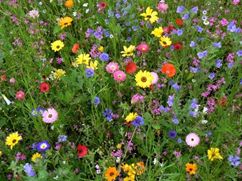
Dear Mr. Tichavsky,
I am from İstanbul. I am studying homeopathy and now interested in saving our tree. It is next to the apartment in which I spent my childhood since 5 and I am 40. That is a very special plum tree more than 35 years old. There are plums on the tree, now green and they will turn to yellow in June. It is being damaged by Sphaerolobium Prunastri.
Thank you
Betul Ayvacı
Radko Tichavsky:
Dear Betul,
It would help if you had a picture of the entire tree with its surroundings: the better simillimum is found by repertorising the holon rather than a single plant or monoculture.
The complex of host (Prunus domestica), parasite (Sphaerolechanium prunastri- SP) and its parasitoids and predators are all native to your area, and their interrelationships are well-studied. When we do not see any pathological symptoms, it does not imply the absence of pathogens.
Rather it signifies the state of balance between the host, pathogens and its natural enemies – all being present in the holon – as the result of its work. Therefore, when symptoms arise, before treating them we have to try to find out what could drive the system out of balance.
SP is univoltine (one generation per year), it overwinters as a second instar nymph, and completes its development by the end of April/early May. It has a strong preference for Prunus Sp., but can feed on 5 families of plants.
This spawns frequent pesticide use, which has direct (phytotoxicity, oxidative stress, DNA damage in plants), and indirect consequences. Pesticides are applied in early April, before most SP develop adult waxy cuticle, so its parasitoids (tiny wasps that lay their eggs in SP nymphs and overwinter together with them) get killed as a result.
In other words: beneficial insects opposing the pathogen are affected more than the pathogen itself. Survey of pesticide-treated vs undisturbed areas in Turkey show heavy SP infestations of trees in the former, and stable parasitism by parasitoids with low % of trees affected in the latter.
The diversity of parasitoids in conserved areas increases over time: from 5 different species in 2001 to 8 in 2006 – resilience of the holon is augmented. Studies conclude that “agricultural workers need to keep in close touch with scientists studying the natural enemies” – so you can become an advocate against pesticide use in your area which would be the most sustainable part of the holohomeopathic intervention in your case, where all parts of parasitoid complex are normally present and are native to the area.
The holohomeopathic treatment strategies include: attracting natural enemies (predators and parasitoids of SP), and strengthening the vitality of your Prunus domestica tree.
- Primary parasitoids in your area: Discodes coccophagus – most frequently observed, Metaphycus silvestrii, Microterys hortulans, Coccophagus lycimnia, C. spartanus. Hyperparasitoids (the parasites of the primary ones) fine-tune the dynamics between primary parasitoids and SP host – the ingenious feedback regulation of populations in undisturbed holons! They are: Aprostocetus trjapitzini (can parasitize hortulans); Pachyneuron muscarum (attacks D.coccophagus); Ceropterocerus mirabilis (parasitize either M. hortulans or D.coccophagus). Early pesticide spraying might not affect these secondary parasitoids (because they normally emerge later), thereby increasing the SP infestation – another “inintended” effect of pesticides. These parasitic wasps are tiny, but you can find out what they look like by checking iNaturalist for local sightings using the scientific name and location: https://www.inaturalist.org/observations?place_id=7183&taxon_id=250477
Careful observation will help you comprehend the complex dynamics; the “joint” parasitism of SP by two parasitoids may inhibit either of them or both, or it may increase the vitality of one or both.
The 5-7 year cyclic fluctuations of all members of this parasitoid complex are observed in undisturbed holons. All of these wasps need nectar (if deprived of food, they lay less eggs), and water.
Have a shallow receptacle with clean water in the shaded part of your garden for them, for beneficial pollinators, and for potential predators of SP-insects and birds. Having bundles of dry leaves, or nearby stone walls as “hiding” places for spiders also helps, they connect to many organisms in the holon, and help controlling the ants that are frequently connected to SP.
Investigation of the signaling chemistry involved would be interesting. If you took the holohomeopathy course, you could repertorize based on the similarity of metabolites between the parasitoids desired, nectariferous plants attracting them, and the Prunus tree.
For example, (z)-3-hexenyl-acetate, the attractant of Metaphycus silvestrii, is a semiochemical common for more than 60 insects, is an attractant for aranae spiders and for C.septempunctata (well-known to prey on scales). It is also common for some plants (including the healthy fruits of P.domestica).
Many orchids produce this and other volatile attractants for a variety of wasps. Platanthera chlorantha is one of such orchid, so it would be good to have it in the vicinity- see this observation in Istanbul, June, 2021 https://www.inaturalist.org/observations/81441582.
Some local “weeds” produce the same attractant substance, and also have metabolical similarity with P. domestica: Chamamelum nobile, Centaurea scabiosa (contains aphidifuge), Cirsium arvense, Eupatorium cannabinum, Matricaria recutita (has aphidifuge).
Chances are you have them in your holon, so just do not eradicate them. Detailed study requires much more time, but suffice it to say, the most common pollinator plants that are good for wasps are from Apiaceae and Lamiaceae families: Mentha piperita (52 common metabolites with P. domestica), M. spicata (50), Ocimim basilicum (60), Coriandrum sativum (78), Origanum vulgare (41), O.majorana (26), Thymus vulgaris (62), Salvia officinalis(54).
All of the same plants can be used in 5-6CH prepared from the MT and sprayed over your tree with Aloe vera gel as coadjuvant, because each of them has at least one aphidifuge, and various beneficial insect attractants in addition to the one mentioned above.
- Your location indicates potential problems with soil salinity, remote sensing indicates extreme drought for the whole month of May, 2021. To increase the vitality of your domestica you need to apply a bionosode of halotolerant/drought resistant bacteria and arbuscular mycorrhizal fungi.
AMF Glomus mossae and G. intraradices can be found in the top 5cm rhizosphere layer of mature Quercus trees (37 common metabolites), healthy Vitis vinifera (very high metabolic similarity!) rhizosphere: blend some soil with molasses (about 5%) and 10% carbonated water, cover with fabric and let stand 1-2 days. Dynamize to 3JT as described in the previous issues, and apply to the rhizoshpere soil of your tree.
It is good to mix it with some slime of Opuntia cacti (chop the cladodes, mix with about 10 parts of water, let stand the same time as the nosode, strain, dynamize and add together before application).
About a week or two later apply the bionosode of Bacillus subtilis or Bacillus megaterium prepared from Aloe vera gel (53 common metabolites) as described in previous issues. Alternately, you can use Curcuma longa root (34 metabolites) prepared with boiled and crushed potato in the same way.
If there is a possibility to find Populus euphratica, prepare its rhizosphere soil bionosode for the soil around your tree (same as Quercus rhizosphere soil). Also use a piece of branch of P. euphratica: peel off the bark, and crush the inside wood, blend it with some water, and proceed with making a bionosode with boiled potato as described before. P. euphratica is an extremely salt and drought resistant tree due to its endophytes (over 100 different strains): Halomonas Sp., Bacillus sp., Serratia Sp., Streptomyces and others. It also cilla orates with Glomus sp. in its rhizosphere. Adapted to the arid, high salt and alkaline environments, it would be ideal candidate for the inoculum source.
Dear Dr. Tichavsky,
I am in Roorkee, India. Temperature: 38C-26C, Humidity: 50%.
- My lemon plant is 6 years old and has never given any fruit. It looks fine otherwise. It bears flowers occasionally but no fruit.
Lemon
- The pomegranate shrub has curling in its leaves. None of the flowers this year bore any fruit. It is around 2 years old. It has been grown in a large plastic tub. (see below)
Pomegranate
- The Capsicum plant has very low production and has leaf curl. It has been grown in a plastic bag with other capsicum plants. (see below)
Capsicum
Thank you!
Guru Charan
Radko Tichavsky:
Dear Guru Charan,
As a general consideration lemon and pomegranate plants need to be repotted in open soil as pots do not allow proper root development.
The lemon seems to have symptoms of HLB Huanlongbing (or Greening) a disease transmitted by psyllid Diaphorina citri is believed to be of bacterial origin (Candidatus liberbacter asiaticus) but some phytoplasmas also contribute to the development of the disease.
Diaphorina citri
In summary, the diseased plants develop asymmetric yellow spots on the leaves, they abort flowers and when they produce fruits they do so in an equally asymmetric coloration.
You can apply aspirin in homeopathic preparation at 3 JT potency and vitamin C 3 JT once a week and spray with a live teacompost bionosode and at the same time fertilize with teacompost.
Since the disease interrupts the communication between the roots and the crown of the tree, both parts must be nourished separately.
You must limit the access of sucking insects and species of the psyllid Diaphorina citri (it is very small and positions itself on the leaves at an angle of 45%) to the plant to limit the reinfection of the bacteria and phytoplasmas.
For this purpose, you should apply Psidium guayava 4 JT (made from TM of the leaves) once a week. During the flowering period apply Borax 6 CH and Phosphorus 12 CH and limit watering.
Transplanting into open soil and the suggested palliative care will keep the plant alive and producing more difficult to eliminate bacteria and phytoplasmas.
The pomegranate should also be transplanted in open soil and Kalium carbonicum 6 CH and live Aloe vera bionosode 4 JT should be applied to the soil.
The cause of leaf curl on chili peppers is the presence of sucking insects such as aphids, thrips, mites, and whiteflies. You can apply every two weeks Boswelia sacra resin 4 JT from TM made in alcohol from frankincense.
Dear Mr. Tichavsky,
Last month I asked about Strawberry fungus and bean plant nutritional problems. Thank you for your detailed analysis and remedies for the problems.
As you have suggested I applied Borax to Strawberry plants and within 8-10 days I could see a big difference and the new shoots are coming up without any fungal issues. After 3 weeks (3 applications of Borax) the fungal problem has almost vanished and the plants are looking very healthy. Thank you for the help and your valuable suggestions.
Regarding Cluster Beans, I prepared bionosode of Aloe vera as you have explained and applied to these plants. After 2 applications, there is some difference and new leaves are much softer and green. I applied Aloe vera nosode to a few vegetable and flowering plants. The Jasmine, Roses, Pumpkin showed noticeable difference after a week and are looking more green and healthy. Is it okay to use it on other plants?
I lost many Green Chilli plants because of leaf curl disease. This time I prepared nosode out of infected leaves and shoots of Chilli plant (same procedure like Aloe vera nosode) and applied it to infected plants. I removed all infected leaves, tips and now new shoots are developing but still with infection. Can you suggest a remedy for Chilli leaf curl disease.
The Papaya plant flower buds drop before the bloom. Any remedy for this.
The lemon plant is susceptible to leaf minor and it attacks only young leaves Also it is not yet started flowering. Will you suggest a remedy for this?
My location: Bangalore, India
Thank you
Murali
Radko Tichavsky:
Dear Murali,
Bionosode vivo can be applied on different plants, but it depends on the metabolic similarity with Aloe vera, since the endophytic microorganisms in two plants with metabolic similarity keep the same degree of similarity.
As for leaves curl in Capsicum you can apply spraying every two weeks or even more often Boswelia sacra resin 4 JT from TM made in alcohol from frankincense and dynamized in water.
Live bionosode from the diseased leaves plant works moderately well as a preventative, but once anatomical modification in the leaves is present the application generally has little effect.
Flower abortion in papaya can be caused by nitrogen toxicity in the soil; you can apply Manganesum 6-8 CH prior to flowering and do not over fertilize with nitrogen rich composts (including cow or other animal dung) and the problem should be fixed.
On lemon plants you can apply Calcarea carbonica 6 CH foliarly and on the soil you should apply lentil germinate in the form of live bionosode. You germinate the lentil for a few days, then blend it with a little non-chlorinated water, filter and prepare the bionosode in non-chlorinated water at 6 JT and you can apply it foliarly and on the soil.
Dear Mr. Tichavsky,
We made compost for the first time this year and spread it on the soil, and in some places worked it into the soil. Most seedlings didn’t come up and those that did look unhealthy. We may have used too much compost. Is it possible to make the soil too acid by using too much compost? If so, is there a way to fix that?
We’re in North Carolina, U.S. We have a humid, sub-tropical climate, with short, mild winters and warm humid summers. Heavy rainfall is common.
Thank you
Arlene
Radko Tichavsky:
Dear Arlene,
Compost generally balances its pH so that it is around pH 7. Imbalances can occur when the nitrogen input (leaves and green plant material predominate over the low carbon input (dry leaves). The amounts of both materials should be equal parts interspersed with a third layer of soil.
That is to say, start with a layer of dry leaves, then a layer of green leaves and then a layer of soil, and so on to exceed a height of 70 cm. Higher heights in the compost can cause acidification due to too much presence of anaerobic microorganisms.
The compost develops in two phases: the first is bacterial and the second is fungal. At the beginning of the first phase, you can apply live bionosode of Aloe vera 3 JT and at the beginning of the second phase you can apply Ganoderma lucidum 3 JT (you can get it on the internet).
First cook for three minutes a fruit of Ganoderma lucidum in a little water, let it cool and place the fruit of the fungus along with the hydrolat in an equal amount of vodka and let it extract for a week. Then proceed to the dynamization 3 JT in non-chlorinated water and apply only once starting the second fungal phase.
Each of the two stages lasts about a month and a half. You will distinguish them by the significant increase in temperature in the first and a less high temperature curve in the second.
The compost should not be stirred during the process and should be irrigated with measure (as if it were a plant) so that it does not dry out but does not get waterlogged with too much water.
The quality and characteristics of the compost can be largely affected by the source of the composting material. For example, if you compost soft leaves, they contain more cellulose and hemicellulose (which are both composed of polysaccharides).
But if you compost parts of trees or shrubs they contain more ligninin which is a diametrically different compound (polyphenols) and requires more intensive and long lasting treatment, but is also the most valuable as it contains multiple mycorrhizal fungi that are beneficial to virtually all crops.
Although the recipe for a common compost is completed in three months, the compost continues to mature and refine its characteristics long after that and we have done sensitive crystallography and chromatography studies that prove that there is an evolution and nutritional refinement in the compost after one, three and five years.
So, making a quality compost is an art that with patience you will master. Just don’t despair and change the compost materials until you get the ideal compost for your crops.
Hi Dr. Tichavsky,
I live in Epanomi, Northern Greece. Our climate is hot during summers around 32-36 degrees and temperature may rise to 42 degrees celsius with average rain 20mm. Humidity is around 53%.
It is cold in the winter with north winds and some snow for a week during December or January and the average temperature is 8 degrees, but may fall to -5 celcious. The average rain is 42mm. Humidity may rise to 75% on January and February. Generally we have humid weather because we are 4km from the sea.
My problem is with my lillum plants (asiatic hybrids) . They are planted in the garden, and this May for the first time, scarlet lily beetles attacked the plants. They eat leaves, flowers, everything.
https://en.wikipedia.org/wiki/Scarlet_lily_beetle
I try to remove them with my hands, but I would like to know If I can use a remedy to help the plants defend themselves.
It is the first time in my life I see this beetle in the garden.
Thank you in advance
Jason
Radio Tichavsky:
Dear Jason,
Adults of Liliceris sp. are extraordinarily voracious and can take over large areas of crop if not properly controlled. It is an exotic pest in Europe and although some parasitizing species have been reported, for example Lemophagus pulcher, Diaparsis jucunda, or Tetrastichus setifer, their action is slow and they are not capable of stopping a massive attack in progress, but rather can serve as a preventive option of medium to low intensity.
Liliceris sp. can be controlled relatively easily with Larrea tridentata 6 CH.( You can get some alcoholic tincture of this plant on the internet.)
Another option is to apply entomopathogenic fungus Beauveria bassiana (you can buy it on the internet) and prepare live bionosode at potency in non-chlorinated water and apply it foliarly and apply 3-4 times until the pest is controlled. You will observe dead insects covered with a white coating of the entomopathogenic fungus as a result of the intervention.
As a preventative for future attacks, you can use live bionosode of Artemisia annua 4 JT (prepared in water) applied foliarly.


